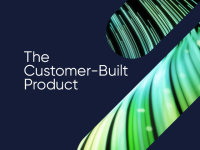How to drive success in your contact center with real-time agent guidance
Our latest blog explores the importance of real-time agent guidance and its role in delivering exceptional customer service experiences in modern cont...
The Team at CallMiner
December 26, 2024


The product experience lifecycle helps companies map the customer journey and understand customers’ thoughts about a product each step of the way. By focusing on continuous user feedback via contact center interactions with customers, companies can determine when and how to improve their products.

In this guide, we’ll break down the stages in the product experience lifecycle, the role of a contact center in managing the product experience lifecycle, and how to leverage insights from customer interactions to drive product innovation and improvement.
In this article:
Product experience refers to the experience a customer has from the moment of discovering a product to their use of the product. The product experience lifecycle is the customer's movement from one point in the customer journey to another and their experiences with the product at each stage. It includes everything from a product’s advertising leading to customer awareness to user onboarding to customer reviews and recommendations.
Modern contact centers use artificial intelligence (AI)-driven tools and software to gather insights from customer conversations and deliver those insights back to the businesses they serve, allowing companies to reevaluate their products and drive innovation.
CallMiner's Chief Marketing Officer, @edubble_u, recently spoke with @IanDBarker of @BetaNews on how effectively leveraging AI and customer data can reveal insights that positively impact #CX and drive business results.
— CallMiner, Inc. (@CallMiner) August 29, 2024
Read the Q&A. ⬇️ https://t.co/rSQuRu8bGw
Product intelligence is a necessary component of the product experience lifecycle. It’s the process of collecting insights about a product, how customers interact with it, and their opinions about it. Companies use this information to identify weaknesses in their products, learn what customers love and want to see more of, make products better, and design new products to meet customer needs.
In a contact center, product intelligence is highly automated with the help of AI. Product intelligence software listens for feedback from customers continuously, gathering contextual insights from real customer conversations as they happen.
Product experience, user experience, and customer experience go hand-in-hand, but they aren’t the same.
User experience refers to customer interactions with a product, and product experience targets the feelings about a product at each step of the customer journey. Both of these come together to create the customer experience, which includes the interactions and feelings a customer has about a brand as a whole, rather than a product.
The product lifecycle can vary depending on the type of product. The steps below are generally the most common parts of a product lifecycle. We’ll explain each stage and how product experience ties in.
The product design stage is the ideation of a product and tailoring that product to meet customer needs. Product development teams use customer feedback and competitor products to create something new, usually with a unique twist that isn’t already available on the market.
After a product is designed and brought to market, customers enter the discovery stage. They’ll learn about the product through advertising or word of mouth and determine whether the product fits their needs. They might visit the company’s website and sign up for an email list to get a discount on the product or learn more about it before buying.
During the user onboarding phase, a company helps potential customers learn more about the product and how it can fit into their lives. The purpose of this stage is to get prospective buyers to turn into customers.
Companies might do this by offering a demo, sharing an overview video, or providing a free trial. For example, organizations interested in CallMiner can request a 30-minute demo with an expert to walk through the software’s features.
When customers sign up, the onboarding stage should continue with guided assistance to help customers navigate their accounts and understand how to use the product. Companies can accomplish this through virtual tours, digital product manuals, or product videos.
Converting leads to sales is one thing, but keeping customers hooked on your product is another. The user retention stage prioritizes keeping the customers who bought your product on your side by helping them realize the true benefits of the product. Therefore, user retention largely focuses on:
Education: Companies should provide educational resources to help customers understand what they’ve bought and how to use it to its full potential. Case studies, an introductory email series, or follow-up phone calls are prime examples.
Self-service options: A knowledge base, blog articles, and automated phone services allow customers to get answers to common questions they have about a product, which can increase customer satisfaction.
Customer support: Quick and reliable customer service is another key to customer satisfaction. Customers should have several ways to contact a company after buying its product to get help when they need it.
More than 70% of senior executives rank #CX as a top priority for the coming years.
— CallMiner, Inc. (@CallMiner) February 17, 2023
Download CallMiner's Customer Loyalty Handbook for insights on how to improve CX, drive loyalty and increase LTV by using solicited and unsolicited customer feedback data. ⤵️
Once a customer buys a product, they should have continued opportunities to leave feedback about that product. Whether it’s through a quick email survey or a review on the company’s website, customer feedback is crucial for improving the product lifecycle and product experience.
Companies should create a welcoming atmosphere for customers to share their thoughts. For example, a software company might invite customers to small or one-on-one virtual meetings to share their experiences, while an online furniture store might send an NPS survey to customers by email after they complete the checkout process. This feedback can go directly toward updating current products and creating new ones, ensuring that customer needs are being met.
The next stage focuses on improving and growing the product based on customer feedback. Companies might use customer segmentation to market their products to target audiences, offer free updates to current customers, and analyze marketing funnels to improve bottlenecks and drop-off areas.
At this stage, customers expect a company to continue reevaluating the efficacy of its products, listen to what customers ask for, and implement the most wanted changes into their product. Failure to do this could prevent customers from being repeat buyers.
After having plenty of time with a product, customers might feel inclined to share their thoughts about the product with others. Product growth can happen exponentially when customers recommend products through word of mouth or social sharing.
Many companies offer referral programs to encourage this behavior, giving customers who introduce others to a product a discount or referral bonus for eligible referrals. They also partner with social influencers to help spread the word.
From a prospective buyer’s standpoint, they might be more likely to have a good perception of a brand and buy its product if they get a recommendation from someone they trust, like a friend, family member, or influencer they’ve followed for several years.
Contact centers have many opportunities to help manage the product experience lifecycle as they communicate with customers across multiple touchpoints. The following strategies and tools can improve the product experience lifecycle across each stage.
Product experience software can make the product journey smooth and efficient. This software uses conversation intelligence to analyze customer conversations and learn how customers truly feel about a product or service, even when they aren’t speaking directly to a contact center agent. For example, product experience software can monitor social media conversations to gather candid insight.
Product experience management tools also provide real-time coaching to agents, allowing them to give customers the most up-to-date and helpful information about a product. This allows the successful introduction and explanation of products to potential customers and personalized support for current customers.
Contact centers should involve all relevant teams in the product experience lifecycle to ensure that every aspect of the product experience, from development to customer support, aligns with the overarching goal of customer satisfaction. Diverse teams also bring different perspectives to the table, leading to more innovative solutions.
Contact centers can foster collaboration by sharing their insights with other teams, like marketing and product development teams. Hosting regular interdepartmental meetings and using integrated tools that automatically share data between teams are excellent starting points.
Contact centers have access to a wealth of data that businesses can use to improve the product experience and manage its lifecycle. The data comes from various sources, including customer feedback surveys, customer conversations and interactions, and performance metrics.
When contact centers continuously gather and review this data, businesses have ongoing data to use in decision-making. For instance, data on individual user behavior can help companies tailor their marketing and product experience to specific customer segments. They can also use data from customer interactions and feedback surveys to prioritize product features and scrap others that aren’t considered valuable to customers.
Customer journey mapping is a crucial part of product experience lifecycle management, as it visually represents customer interactions with a product. Through customer journey mapping, a company can learn how customers engage with products at each stage, from awareness to drop-off.
Contact centers can help businesses create their customer journey maps with the data they gather, which they can share with company stakeholders, departments, and decision-makers for continuous product improvement.
Customer feedback loops are systematic processes that gather and analyze customer feedback, ultimately arming businesses with actionable data they can use to improve product experiences. They create an ongoing communication cycle between customers and company agents, allowing customers to ask questions or share their thoughts and the company to provide support and ensure customer satisfaction.
Customer feedback loops can help companies spot issues early on in the product experience lifecycle to prevent further interruptions down the road. They also allow companies to shift their focus as customer needs evolve over time.
Contact centers can use the data they gather to learn what customers need and the questions they want answered about a product. Then, they can use this information to create self-serve knowledge bases for customers to get the help they need quickly and conveniently, even if they don’t have time to call the company for support.
A self-serve knowledge base can include frequently asked questions, product manuals, troubleshooting information, walk-through videos, virtual chat assistants, and other types of content that can put customers back on track with a product or service.
Delta Defense is growing and changing rapidly, and they needed a singular platform for call coaching and customer insights.
— CallMiner, Inc. (@CallMiner) September 12, 2024
Hear how they're using CallMiner to capture unsolicited feedback from customer calls and share that data enterprise-wide. ⬇️https://t.co/0LFXjxyKa1 pic.twitter.com/nTLDq4dHEl
Product experience software can help all departments involved in the customer journey and product development, including marketers, customer service agents, and project managers, get the insights they need to create usable, valuable products for customers.
CallMiner Eureka listens to customers at every contact point to collect feedback across customer touchpoints. With this information, your company can create competitive products that stand out from the pack and cater directly to customer needs.
Book a demo today or contact the CallMiner team to discuss your needs and learn what CallMiner’s conversation intelligence platform can do for you.
The product lifecycle is the stages a product goes through, from development to decline. The product experience lifecycle refers to the ongoing interactions and feelings a customer has with a product at every stage of the customer journey, like onboarding and customer feedback. Companies use the product experience lifecycle to get continuous feedback to inform necessary product updates and enhancements.
Companies can use product experience lifecycle software to gather continuous feedback from customers at every stage of their journey with a product. Several key performance indicators (KPIs) measured by this AI-powered software can also draw helpful insights, like user engagement rates and churn rates, to determine what product areas are lending to or drawing from the customer experience.
The product lifecycle generally happens in four stages.
The first stage is the introduction, during which customers get introduced to the product through referrals, advertising, or other means. The next stage is growth, defined by customers becoming more aware of the product and, in turn, increasing the product’s popularity in the market.
The third stage, maturity, is when a product becomes well-known in the market and sales may begin to slow, making customer retention a key component of this phase. Finally, the decline stage marks the end of the product lifecycle, typically defined by a drop in sales and decreased demand.